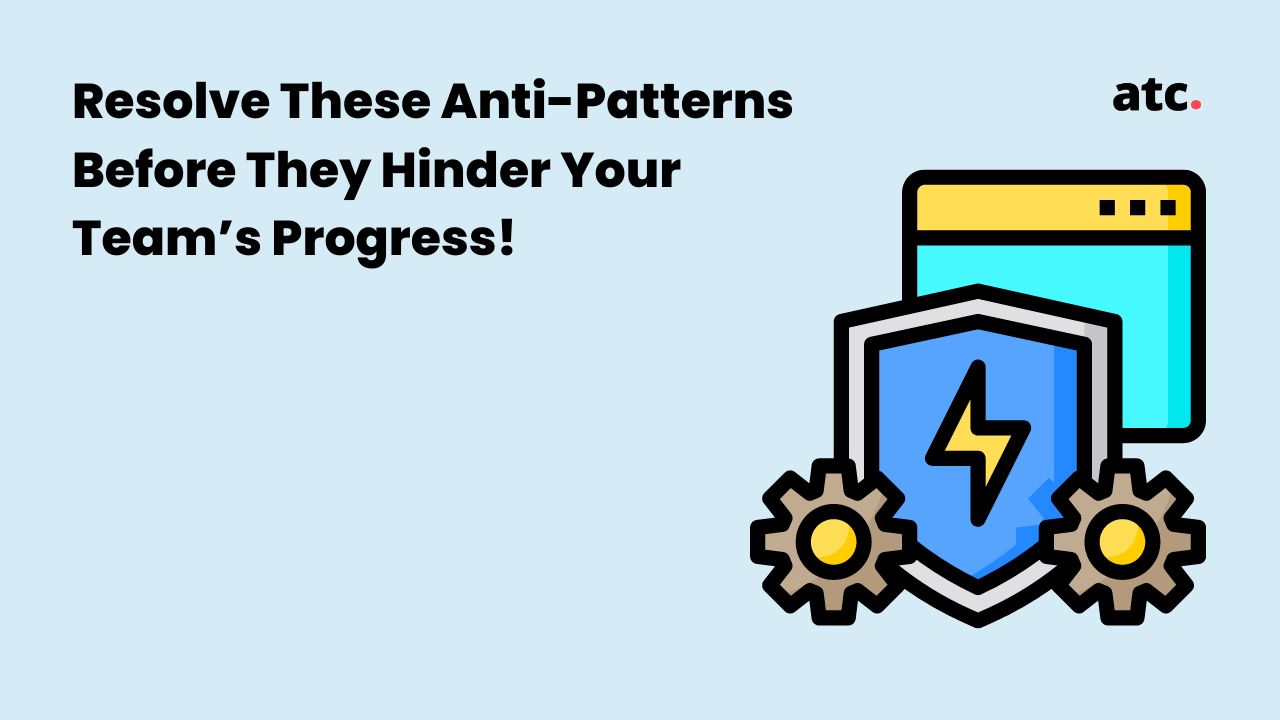Subscribe to the blog
Having a worldwide adoption of 87 percent, Scrum has unlocked a powerful way for companies to deliver customer value and reduce time-to-market.
But it comes with its own challenges. And sometimes, to resolve the challenges associated with day-to-day Scrum activities, Scrum Masters and Product Owners apply anti-patterns. It may seem like anti-patterns help resolve a situation, but it has negative consequences.
Below, we have listed everything about Scrum anti-patterns, including what they are and how to address them effectively.
What Are Scrum Anti-Patterns?
The term was coined in 1995 by industry expert Andrew Koenig.
According to his research, there are two critical elements to an anti-pattern:
- The anti-pattern is a commonly-used process, structure, or pattern of action that, despite initially appearing to be an appropriate and effective response to a problem, has more bad consequences than good ones.
- Another solution exists to the problem the anti-pattern is attempting to address. This solution is documented, repeatable, and proven to be effective where the anti-pattern is not.’
In a nutshell, Scrum anti-patterns are typical behaviors and practices that may seem appealing and help solve a recurring problem, but have negative consequences. These practices fail to follow Scrum values and principles and can lead to problems, such as increased project costs, lower-quality products, and delayed timelines.
Anti-Patterns That Scrum Masters Should Watch Out For!
Scrum Masters are in charge of facilitating multiple Scrum ceremonies and motivating the development team. But it can be overwhelming to do everything at once.
Here are the top 3 anti-patterns that Scrum Masters should avoid to ensure that they don't impede the team’s performance:
- Making Teams Dependent
This anti-pattern revolves around the Scrum Master micromanaging the team’s work and not empowering them to make independent choices. This behavior creates an environment where the team becomes reliant on the Scrum Master to make crucial decisions, solve problems, and determine the direction of the project.
As this behavior goes against the principles of Scrum, it can harm the team's ability to work effectively and thus prolong the deadlines.
How to overcome this situation?
A Scrum Master should create an environment of trust, collaboration, and empowerment to help the team reach its full potential. They should move away from control-and-command behavior and double down efforts on breaking down silos, giving teams access to the tools they need, and overseeing their work with a light but consistent touch.
- Teams Assuming the Role of a Scrum Master As a Manager
Although Scrum Masters perform diverse duties, their role is distinctly different from project managers. But most people use the terms interchangeably. This confusion is because the Scrum Master performs administrative tasks, such as scheduling meetings, keeping the team's progress visible, and reporting the sprint findings.
However, it is crucial to understand that their primary responsibilities include becoming a servant-leader and facilitating Scrum events to help the product owner and the development team continuously improve.
How to overcome this situation?
Here, the problem is that people don’t understand the terms ‘servant leadership’ and ‘facilitator’. The Scrum Master should step in and provide a clear distinction on the terms, what they are trying to achieve, and how their role is different from a typical project manager.
As per the Scrum Guide, a Scrum Master is a servant-leader whose focus is on addressing the needs of the team members to help them achieve goals in line with the company's values, principles, and business objectives.
As a servant-leader, the Scrum leader is responsible for:
- Facilitating Scrum events: This includes facilitating events such as sprint planning, daily Scrum, sprint review, and sprint retrospective. Their role is not to schedule the meetings but to ensure they are effective, time-boxed, and productive.
- Coaching and mentoring the team: Scrum Masters must teach, mentor, and coach the team members in adopting the Scrum methodology. It also involves guiding the team towards self-organization.
- Creating a collaborative culture: They must create an environment that encourages Scrum values like transparency, inspection, and openness.
- Shielding the team from disturbances and threats: It involves addressing organizational, interpersonal, or technical issues arising during the sprint.
P.S. Here’s a guide to help you make the most out of Scrum gatherings!
- Reinforcing a ‘No-Failure Culture’
With deadlines looming, Scrum Masters face a difficult challenge: ensuring teams deliver on their commitments without compromising the quality of work. To ensure success in this balancing act, many promote an atmosphere that encourages excellence and discourages failure. However, in Scrum, failure is seen as an opportunity to learn and improve. This is because the resulting increment ultimately falls into the customers’ hands. So the focus is not on how to avoid failure but on how to embrace it and move forward.
How to overcome this situation?
The Scrum Master should follow the principles of ‘continuous improvement', helping teams to inspect and adapt their work and processes.
Here are the top things a Scrum Master must do to facilitate a culture of continuous improvement.
- Celebrate failure and emphasize learning: Encourage the team to focus on learning from their experiences. Conduct regular retrospectives and discussions, where you help the team reflect on their work and identify improvement areas.
- Do not play the blame game: Avoid blaming individuals for failures or setbacks. Instead, work on the process and system that allowed the loss to occur.
- Encourage experimentation: Motivating the team to work on new ideas and approaches is crucial. It improves the team's confidence in taking risks and finding better ways to deliver customer value.
- Create a feedback loop: You can encourage teams and stakeholders to give and receive feedback through Scrum events such as sprint reviews and sprint retrospectives to identify issues early for the next sprint.
Scrum Anti-Patterns That Product Owners Should Watch Out For!
Let’s explore the top Scrum anti-patterns that product owners should avoid at all costs.
- Creating an Over-sized Product Backlog
A critical responsibility of a product owner is refining the product backlog. If the items are not groomed and are too large, it can lead to the following consequences:
- Increased lead time: As there is a long list of items to complete, the lead time to deliver a feature also increases. This causes dissatisfaction among customers.
- Prioritization becomes challenging: A lack of clarity about what the team should be working on can lead to failure in completing the priority items.
- Pruning dead items becomes harder: While creating a product backlog is crucial, refining it as per changing requirements is equally important. But if the list is too long, pruning dead items become tough and increases overheads.
How to overcome this situation?
Let’s look at the top industry practices on what product owners should do to create a perfectly groomed product backlog:
- Make it a team exercise: Product Owners should work closely with the Scrum Master and the development team to get a realistic understanding of how much work the team can handle. User story estimation and sprint planning are efficient tools to help product owners do that.
- Review the backlog based on customer needs and business goals: Everyday end-users, customers, and stakeholders come with multiple requests, which they argue to be urgent. But product owners should review and prune the backlog based on solid market research and logical reasoning so that the team is not distracted from the actual business goal.
- Learn to say no: Successful product owners know how to say no to unnecessary requests from stakeholders. Their job is to simplify the backlog so that the team is not bombarded with too much.
Keen to know more about how to estimate user stories? Here is a guide with valuable insights.
- Acceptance Criteria For Certain User Stories Are Missing
In Agile, acceptance criteria are a set of specific, measurable conditions that must be met to mark a user story or feature "done" and accepted by the product owner. They are developed collaboratively by the product owner and the development team to create a shared understanding of what is expected from the user story.
If acceptance criteria are missing, it can create the following problems:
- Unclear expectations: If the development team is not clear on what needs to be delivered, they will not be able to verify the item or meet the product owner's expectations.
- Delayed feedback: It can be challenging for the product owner to provide timely and relevant feedback on the deliverable, which can create longer development cycles.
- Inconsistent quality: The quality of the deliverable can vary as the expected quality standard is not mentioned.
How to overcome this situation?
Product owners can avoid this Scrum anti-pattern by following these guidelines:
- Focus on user needs: It is crucial to note that every acceptance criterion should be from the user's perspective. Start by defining the user needs or business goals that user stories should address.
- Make them specific and measurable: Acceptance criteria should be measurable and testable. They should describe the desired functionality or behavior of the feature clearly and concisely.
- Include edge cases and constraints: Identify any edge cases or constraints that apply to the user story. And make sure to add them to the acceptance criteria.
Understand That No Sprint is Perfect!
While the Scrum framework adopts an iterative approach toward software development where everyone should reflect on their work, most leaders want sprints to be perfect and well–timed. This is not an ideal notion as Scrum development projects run in a complex environment, and often unexpected challenges crop up. But this doesn’t mean that you can weed out common Scrum anti-patterns.
The anti-patterns, as mentioned above, are just a few examples. To identify others in your team, you need to reset expectations and gather continuous feedback to ensure productivity.
And if you want to learn more about the Scrum framework, including its values, tools, and best industry practices, we offer an instructor-led training program that will walk you through the intricacies of the framework through real-world examples, industry-driven case studies, and group practices.
Check out our training calendar to learn more about our instructor-led Agile, SAFe, and Scrum training.
Frequently Asked Questions About Scrum Anti-Patterns!
- What are some common Scrum anti-patterns?
Some common Scrum anti-patterns include bureaucratic Scrum ceremonies, poorly defined user stories, failure to adapt to changing requirements, lack of collaboration, and siloed departments.
- How do Scrum anti-patterns impact the performance of a development team?
Scrum anti-patterns impair the development team’s performance in several ways. Due to unclear requirements, lack of support, and spending too much time on unnecessary tasks, development teams face the consequences of increased risk factors, delayed project timelines, decreased motivation, and reduced innovation.
- What are some strategies for identifying and addressing Scrum anti-patterns?
Some common strategies include reflecting on past works, resetting expectations, facilitating healthy discussions, and working on customer feedback.
- Why do Scrum anti-patterns exist?
The Scrum framework may look straightforward, but it has many underlying intricacies. And while addressing these intricacies, Scrum masters and product owners may apply anti-patterns, leading to negative consequences.




